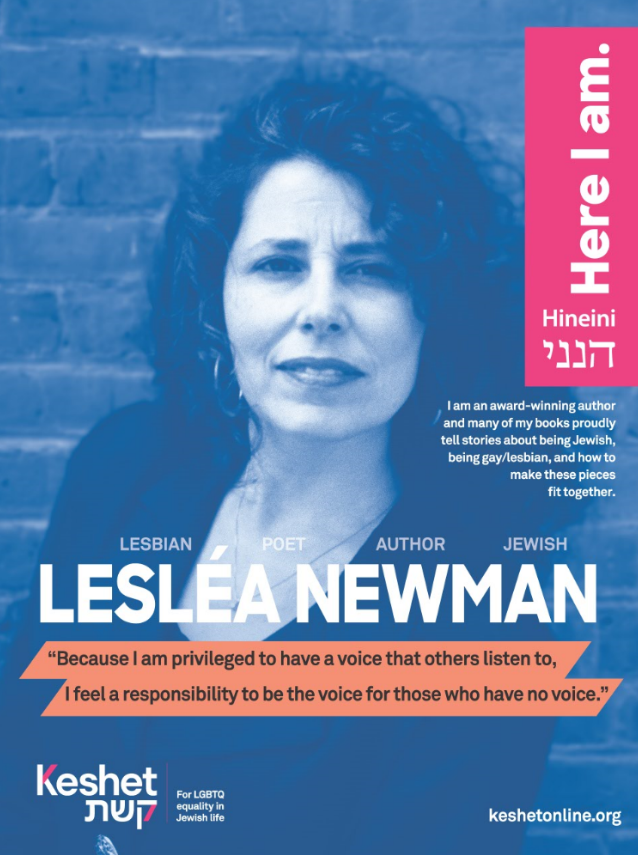
This lesson is about reflecting on the messages sent to us through media and considering the power of representation.
By Essie Shachar-Hill, Keshet
 Introduction
IntroductionTime: 45 mins
Age: 11+
Materials:
Goals:
Considerations:
Today we will be learning about a contemporary Jewish hero. It’s important to learn about Jewish heroes because there are so many extraordinary Jews in our history and present who have made important contributions to the Jewish people and the world at large. It’s also important to learn about lots of different Jewish heroes because it uplifts the fact that the Jewish community is diverse, and there is no one way to be Jewish. Today we are going to learn about Lesléa Newman.
Lesléa (pronounced “Lez-LEE-uh”) Newman (she/her/hers) is the author of 70 books for readers of all ages. Ms. Newman wrote Heather Has Two Mommies, the first children’s book to portray lesbian families in a positive way, and has followed up this pioneering work with several more children’s books on lesbian and gay families: Felicia’s Favorite Story, Too Far Away to Touch, Saturday Is Pattyday, Mommy, Mama, and Me, and Daddy, Papa, and Me.
She is also the author of many books for adults that deal with lesbian identity, Jewish identity and the intersection and collision between the two. Other topics Ms. Newman explores include AIDS, eating disorders, butch/femme relationships, and sexual abuse. Her award-winning short story, A Letter To Harvey Milk, has been made into a film and adapted for the stage.
There’s a lot we can learn from children’s books, even as teens and adults! They often contain messages about values, expectations, and life lessons. We’re going to take a look at a smattering of children’s books and see what we remember from them.
If virtual: This activity uses Padlet, which is an interactive, visual teaching tool. Re-make your own version of this Padlet board. (You can do this by clicking “re-make” at the top right corner. Make sure to click “copy posts” so the main content is also copied. Please be sure to re-make the Padlet for your lesson rather than directly editing the template!! This will ensure the template stays unedited so others can re-create padlets from it.)
Share the link to your padlet with your class.
The directions for this activity are at the top of the Padlet, and you can read them aloud:
Find a book that you are particularly drawn to. If you’re familiar with the book, write a word or short phrase that captures the central idea of the book. If you have a favorite children’s book that does not appear here, find an image of the cover on Google Images, click Copy, put your mouse on an orange space on this padlet board and click, then paste (Ctrl+V or Command+V). It’ll show up at the top of the Padlet. Happy reading!
Ask a few students to share verbally once people have had a chance to peruse and annotate.
If in person: Project or display the padlet so all students can see it. Have students take turns choosing a book and briefly sharing the main message of the book.
Now we’re going to look at a children’s book by Lesléa Newman. Watch “Sparkle Boy read by author.”
Either as a whole group, or in smaller groups, discuss the following:
Facilitator’s note: this is a good time to talk about representation and the power of seeing oneself reflected in media. See appendix for more resources.
Think about a message or lesson you wish you had learned as a child. Create an outline for a children’s book that teaches that lesson. Include at least the characters and themes. If you have time, start mapping the plot!
As we’ve seen, the messages we receive as children can have a great impact on our lives. What were the messages/themes you wanted to include in your children’s book?
If virtual: have participants annotate a Zoom whiteboard
In person: Have a snowball fight! Have each student write their message on a piece of paper, crumple it up, and throw it to the center of the room. Then have students pick one from the pile and read aloud.
if you have more time, multiple lessons, or want to assign homework
Appendix